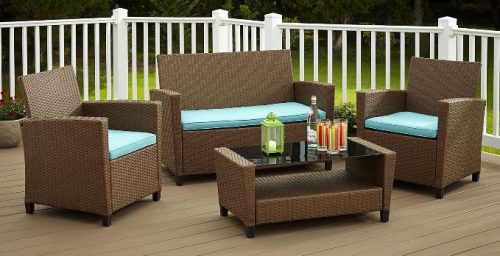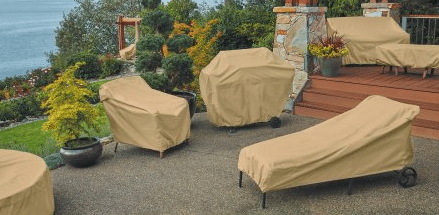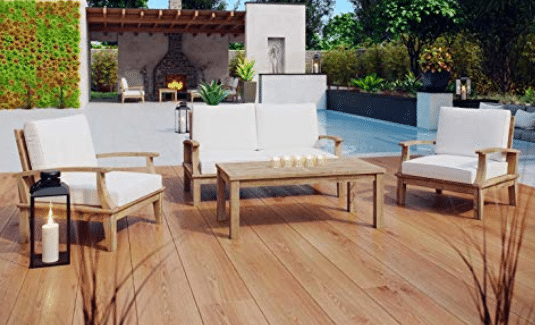Sustainability isn't just a buzzword anymore – it's becoming a way of life, especially when it comes to our outdoor spaces. By embracing sustainable practices, we're not only giving back to the environment but also crafting a more mindful home for ourselves. And let's face it, who doesn't want a patio that looks great and feels responsible?
Eco-friendly patio furniture is catching on. This is a win-win for your backyard hangouts and Mother Nature. Imagine having furniture that doesn't harm the ecosystem but instead promotes a cycle of reuse and ethical sourcing. The days of choosing style over substance are over – now you can have both.
The variety of eco-friendly options is impressive. Whether you're a fan of woods like teak or eucalyptus, or you prefer the chic look of recycled resin wicker, there are plenty of choices to suit every taste and every garden. So yeah, it's not just possible to have an awesome-looking patio that's also kind to the planet, it's pretty easy too!
Choosing mindful materials helps you step up your game in outdoor living. And it feels good knowing that each piece you pick contributes a little towards a healthier planet. In the sections coming up, I'm gonna guide you through the best eco-friendly materials, design tips, and ways to keep your furniture looking fresh for years.
Benefits of Choosing Eco-Friendly Patio Furniture

Going green with your patio furniture offers a range of benefits that go beyond just doing your bit for the planet. First off, it's about reducing your environmental footprint. By selecting materials that are sustainable, you're helping preserve vital ecosystems, supporting ethical labor practices, and reducing waste – all while enjoying a vibrant outdoor space.
Eco-friendly materials aren't just about sustainability; they're built to last. Durable designs mean you won't be replacing furniture as often, saving you money in the long run. These materials can withstand the elements better than some traditional options, adding years to their longevity. Plus, who doesn't love the idea of furniture that stays stylish and sturdy through time!
And here's where things get even better: natural materials have a unique aesthetic appeal. Wooden pieces have a timeless charm with distinct grains and textures that add warmth to any setting. Resin wicker brings a modern edge while remaining conscious of its environmental impact. These eco-friendly materials not only enhance the look of your garden but offer the peace of mind that comes with sustainable choices. So while you're relaxing on your patio, you're also supporting a healthy planet – that's a pretty great combo, right?
Essential Materials for Eco-Friendly Patio Furniture
Wood is a classic choice when you're thinking about eco-friendly patio furniture, but not just any wood will do. Sustainable options like teak, cedar, and eucalyptus shine here. These woods aren't only durable and naturally weather-resistant; they're often sourced responsibly, making them a great pick for the eco-conscious.
The notion of FSC-certified wood is something you should be familiar with. It ensures that the wood comes from well-managed forests that provide ecological, social, and economic benefits. So when you spot this label, you know you're onto a good thing.
For the upkeep of wooden furniture, it's all about maintenance. Regular oiling and a good cover in wet weather can prolong its life incredibly well. A bit of elbow grease now saves you hassle later!
Moving on to resin wicker furniture, it's a popular alternative that balances style with responsibility. There's a choice between natural and synthetic wicker. Natural wicker has an earthy vibe but might not stand up against harsh weather like its synthetic counterpart, which also happens to be recyclable.
Recycled resin wicker is incredibly durable and weather-resistant. Plus, it involves processes that lessen environmental harm, making it a responsible option. Whether you're dealing with sun or rain, this material has got your back.
When picking this kind of furniture, consider brands that use eco-friendly manufacturing practices. It’s reassuring to know your cool patio set didn’t cost the Earth more than it needed to.
Crafting Eco-Conscious Outdoor Designs
Blending materials like wood and resin wicker can give your outdoor space a modern, earthy vibe that's both stylish and kind to the environment. It's about creating a balance between nature and design, allowing each piece to complement the other.
Don't underestimate the power of color in your patio design. Neutral and natural tones work wonders in creating a calm, relaxing oasis. Earthy colors resonate well with sustainable materials, enhancing the overall look and feel of your patio.
The final touches often make the biggest impact. Eco-friendly cushions and decor items add comfort and personality without compromising on sustainability. Opt for textiles made from organic or recycled materials to ensure every element of your patio ties back to your commitment to the environment.
In designing your space, consider multipurpose furniture that can adapt to different settings or occasions. This not only reduces the number of items you need but also keeps your patio space from feeling cluttered.
Lighting is another aspect where eco-conscious choices can shine – literally. Solar-powered lights are a brilliant way to illuminate your space sustainably and cost-effectively.
The goal is to craft a setup that's as green as it is great-looking, where each element reflects careful thought about its environmental impact.
Navigating the Eco-Friendly Marketplace
Shopping for eco-friendly patio furniture can sometimes feel like walking through a jungle of labels and certifications. Knowing what to look for is crucial. Trusted certifications like FSC for wood and GREENGUARD for indoor air quality can guide you to truly sustainable options. These badges often tell the story of a product's lifecycle, from sourcing to manufacturing.
It's worth diving into a little brand research. Companies committed to sustainability often share details about their environmental impact and labor practices right on their websites. Look for brands with transparency about their materials and processes. It shows they genuinely care about their footprint.
Avoiding greenwashing is key. That's where a product claims to be environmentally friendly but doesn't meet the mark. Always check the facts behind those claims. Exaggerated green credentials without clear explanations are often red flags.
Ask questions – both of the product and the retailer. Where do the materials come from? How is the product made? Reliable sellers will have these answers on hand.
Ultimately, being informed and inquisitive can save you from purchasing something that’s only green in name, ensuring your outdoor space is as sustainable as it is enjoyable.
Maintenance and Longevity of Eco-Friendly Patio Furniture

Keeping your eco-friendly patio furniture in top shape doesn't have to be a chore. Some simple cleaning tips can go a long way in extending its life. For wooden furniture, regular dusting with a soft cloth helps maintain its natural shine. A mild soap mixed with water can tackle tougher spots, ensuring the wood isn’t overexposed to moisture. Using a protective sealant periodically is a good idea too.
When it comes to resin wicker, a light scrub with a solution of warm water and vinegar does wonders. It clears away grime without harsh chemicals, keeping the material's integrity intact. For resin pieces, make sure not to let dirt build up in the weaves, as it can become a headache to remove later.
Protecting your furniture from extreme elements is crucial. Using covers during off-seasons or harsh weather shields your furniture from unnecessary wear and tear. Opt for breathable covers to prevent moisture build-up underneath.
Instead of tossing out damaged pieces, look for repair options. Many eco-friendly brands offer fixes or replacements for worn-out parts. This approach not only saves resources but also supports the circular economy.
Recycling is another road you can take. Many communities have facilities for repurposing materials like metal and wood. Research local programs to ensure your old furniture is given a second life instead of just ending up in a landfill. Making sustainable choices in every step of your outdoor decor journey helps keep the bigger picture in mind.



